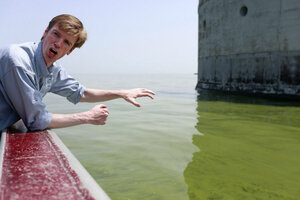Toledo water ban lifted: Will crisis prompt pollution control efforts?
Toledo, Ohio, residents took this weekend's water ban in stride, which was put in place after water supplies tested positive for a toxin associated with algae blooms. Fertilizer runoff could be to blame.

Collin O'Mara, president and CEO of the National Wildlife Federation, talks about algae near the Toledo water intake crib, Sunday, in Lake Erie, about 2.5 miles off the shore of Curtice, Ohio. The bloom triggered a water ban that left some 400,000 residents unable to use their taps for two days. The mayor of Toledo lifted the ban Monday morning.
Haraz N. Ghanbari/AP
Ohio officials lifted a water ban Monday that sent hundreds of thousands of Ohio and Michigan residents scrambling for bottled water over the weekend.
Toledo Mayor D. Michael Collins announced that the water is once again safe to drink around 9:30 a.m. Monday morning. Officials have advised residents to flush their systems before resuming use of tap water, but urged people not to rush to do so immediately, as that could overwhelm the system.
Health officials issued the ban for more than 400,000 residents in northwestern Ohio and southwestern Michigan on Saturday morning after water supplies tested positive for microcystin, a toxin associated with algae blooms. Residents were unable to use their tap water for drinking, cooking, or brushing teeth. Officials advised residents not to attempt to boil the water, because that could concentrate the toxin rather than destroy it. Health officials said that children and people with compromised immune systems should also avoid bathing in the water.
"The people of Toledo came together unselfishly to support one another over the past two days and are great examples of the Ohio spirit," Ohio Gov. John Kasich (R) said in a statement following Mayor Collins's announcement Monday morning.
Katie Peters, a teacher, told The New York Times that she had been impressed by how willing residents were to help one another through the water crisis.
“Our community has really come together,” she said. “We have people who don’t know each other offering to deliver water.”
She drove an hour away to a Wal-Mart in Michigan to purchase water so that the National Guard would have enough to support those who were unable to travel.
Toledo high school teacher Randy Nissen told the Times that he drove to a friend’s house outside the restricted area to fill up containers with water. He said he took the inconvenience in stride, but expressed concern that officials are not doing enough to address the underlying causes of the contamination.
“I’m worried that when the water comes back on, everything will go back to the status quo, and no one will address the problems that caused this,” Mr. Nissen said this weekend.
Officials believe an algae bloom in Lake Erie led to the contamination. Algae blooms have become increasingly problematic in Lake Erie, the smallest and shallowest of the Great Lakes, most likely because of fertilizer runoff from area farms. The amount of phosphorous going into the lake has risen every year since the mid-1990s.
“People are finally waking up to the fact that this is not acceptable,” Collins said during an earlier press conference, according to the Associated Press.
Some 11 million people, including residents of Toledo, Ohio’s fourth largest city, rely on Lake Erie for drinking water, and water treatment operators have been warning of this scenario for several years.
Governor Kasich pointed to the incident as a stark reminder of the vital role the lake plays in the communities surrounding it.
"Over the past two days we've been reminded of the importance of our crown jewel – Lake Erie – to our everyday lives. We must remain vigilant in our ongoing efforts to protect it," Kaisich said in his statement.
• This report includes material from the Associated Press.

